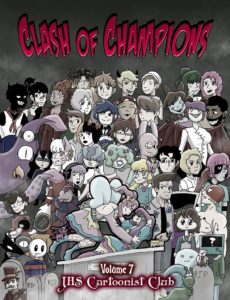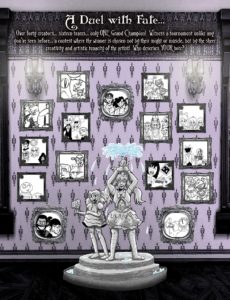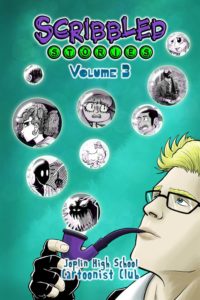Joplin High School Cartoonist Club titles


 This was almost the shortest book review submitted here: “Read them! They’re wonderful!” Because that’s all you really need to know about the books published by the Joplin High School Cartoonist Club.
This was almost the shortest book review submitted here: “Read them! They’re wonderful!” Because that’s all you really need to know about the books published by the Joplin High School Cartoonist Club.
It’s easy to gush about the delightful results of local students’ creativity and hard work. And, it’s loads of fun to see a new batch of artwork every year then watch audiences enjoy it, too. Forgive my shameless fangirling, but these books are the most consistently fun, intriguing, surprising series I’ve read in a long time.
The JHS Cartoonist Club, helmed by sponsor Seth Wolfshorndl, is in its thirteenth year and has grown tenfold from a starting group of five students. During the school year, club members meet to learn new drawing techniques, stretch their creativity, and explore storytelling through pictures as well as words–all while having fun in the process. Each spring the Club publishes a new volume in its two ongoing series.
Clash of Champions, perhaps the more visible of the series because it plays out annually on the Club’s Facebook page, is the culmination of a lengthy comics tournament. Beginning in the fall, club members create teams of characters who are matched against each other, bracket style, in weekly duels. Members draw panels of “smack talk”, comics which are designed to show how and why a particular team would win a duel. Each duel’s outcome is voted on by club members. The last team remaining at the end of the tournament wins.
Volume 8 of Clash of Champions showcases the 2019-20 school year’s tournament which was completed prior to the pandemic shutdown. In it, 16 teams and 41 creators showcase their talents during a storytelling battle of epic proportions. Introductions come first via the “Team Gallery” where characters’ poses hint at their personalities and where readers discover the artists behind the teams. I love how the gallery pages are bordered in what looks like an embossed metal frame that lends a goth-steampunk vibe at the start. The team names alone made me want to keep reading: Krankenhaus Hoodlums, Beam Battalion, Sparkle Sqawd, The Four Crustmen of the Apocalypse, and Why Not? The battle panels reflect a wide range of aesthetic influences (from anime to He-Man to 1960s beach party movies) and a variety of media (inked-in pencil sketches to digital drawings). After the winner is declared, the final chapter gathers fan art that club members have made of each others’ work.
There’s no playing favorites in the competition although I’m a fan of the smack talk segments. For me, the best part of Clash is following the growth of the artists, watching their work develop over the semester, seeing who is on their game and who is challenged by the deadline in any given week. A black-and-white format can sometimes lay bare too much when compared to the distraction of color, but here it’s an opportunity to learn and to appreciate the skill involved in creating new material quickly.
Scribbled Stories takes a different approach to self-expression and storytelling. Club members submit tales with subjects and characters of their choice. Although Scribbled Stories publishes an issue annually, every four years the issues are gathered in a single volume. The students choose a theme for the bound volume and often reflect the theme in their submissions.
Also published in the 2019-20 school year, Volume 3 of Scribbled Stories collects works from 2016-20 under the theme of surrealism and shows off a new twist. This time the Cartoonist Club collaborated on a story and main character. Club artists made a cast of minor characters and brainstormed a plot which became a script written by Mr. Wolfshorndl. Pages of the story were assigned to the students, and the result is a rollicking, action-packed spin through dreamland amid a host of artistic styles.
It’s the variety, ingenuity, and scope of the work that pulled me into Volume 3. The “Character Sketches” section highlights a cast including a monocled soap bubble sporting a top hat (Mr. Fancy Bubbleman), a talking cup of coffee (Joey), and a rosy-cheeked doll who looks Rainbow Brite-meets-Chuckie (Surrealist Sophie) and is anything but boring. Scripts of the student-submitted works are witty and poignant, thought-provoking and heart-breaking. Although “Wake Up” uses only one word, it conveys the horror and pain and isolation of a person consumed by screen time. “Just for One Day” explores memory and loss by arranging photographs comic-panel style with brief, superimposed text. “Nightfall/Daybreak” spins a myth of the sun and moon with poetry in words and pictures. There is so much to see and enjoy here!
I highly encourage you to try the fun, awesome comics by the Joplin High School Cartoonist Club. Whether it’s Clash of Champions or Scribbled Stories or both, read them! They’re wonderful!

